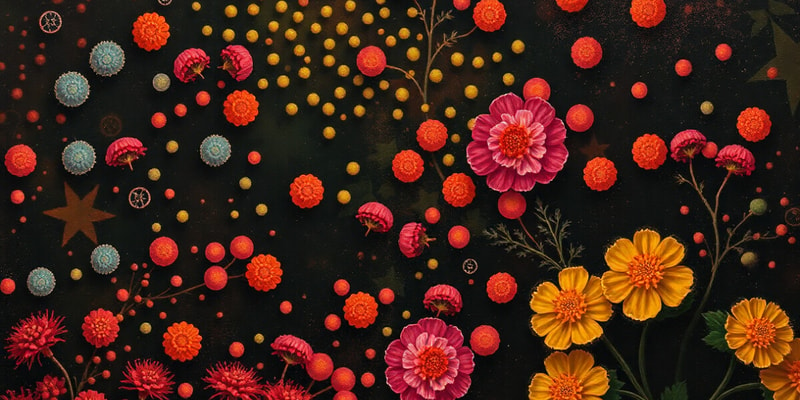Podcast
Questions and Answers
What distinguishes archaea from eubacteria?
What distinguishes archaea from eubacteria?
Which process involves the transfer of DNA between bacteria using a virus?
Which process involves the transfer of DNA between bacteria using a virus?
Which characteristic is true for gram-positive bacteria?
Which characteristic is true for gram-positive bacteria?
Which of the following statements is accurate regarding opportunistic pathogens?
Which of the following statements is accurate regarding opportunistic pathogens?
Signup and view all the answers
What is the primary component of the oral microbiome in terms of microbial cell count?
What is the primary component of the oral microbiome in terms of microbial cell count?
Signup and view all the answers
Which of the following best describes the role of antimicrobials?
Which of the following best describes the role of antimicrobials?
Signup and view all the answers
Which of these morphological forms of bacteria can occur in cluster arrangements?
Which of these morphological forms of bacteria can occur in cluster arrangements?
Signup and view all the answers
Which type of bacteria would most likely survive extreme temperatures and toxins?
Which type of bacteria would most likely survive extreme temperatures and toxins?
Signup and view all the answers
Study Notes
Prokaryotes and Eukaryotes
- Prokaryotes: Eubacteria and Archaea
- Unicellular
- No nucleus
- Circular DNA
- Asexual reproduction
- Bacteria have peptidoglycan cell walls, Archaea do not
- Archaea have isoprene chains instead of peptidoglycan
- Eukaryotes
- Have a cytoskeleton
- Can be pathogenic
Types of Microorganisms
- Bacteria
- Archaea
- Fungi
- Algae
- Protozoa
- Viruses
Taxonomy
-
Domain
-
Kingdom
-
Phylum
-
Class
-
Order
-
Family
-
Genus
-
Species
-
S.mutans (Streptococcus mutans)
- Class: Bacilli
- Order: Lactobacillales
- Family: Streptococcaceae
- Genus: Streptococcus
-
Genus and species are always written in italics
Morphology
- Cocci types:
- Diplococci
- Aceria
- Staphylococci
- Spirochete
- Physillus
- Vibria
Gram Staining
-
Crystal violet differentiates bacteria based on cell wall structure
- Does not stain all cells
-
Steps:
- Crystal violet
- Iodine
- Ethanol (decolorization)
- Safranin (counterstain, stains all cells pink)
-
Gram-positive bacteria:
- Thicker cell wall
- Appear blue/purple
- 90% peptidoglycan
-
Gram-negative bacteria:
- Thinner cell wall
- Appear pink/red
- 10% peptidoglycan
- Can trigger sepsis
Genetic Recombination in Bacteria
- Transformation: Bacteria take up DNA floating in the environment
- Transduction: DNA transferred from one bacterium to another by a virus
- Conjugation: DNA transferred between bacteria through a tube
Other Bacterial Features
-
Endospores:
- Not true spores
- Dormant bacterial cells
- Survive high/low temperatures and toxins
- Found in Bacillus and Clostridium
-
Oxygen tolerance:
- Obligate aerobes
- Obligate anaerobes
- Facultative anaerobes
- Aerotolerant
-
Temperature tolerance:
- Psychrophiles
- Mesophiles (optimal at 37 degrees Celcius)
- Thermophiles
Relationships with Organisms
- Commensal: Bacteria living in the host without causing harm
- Opportunistic pathogens: Cause infection when the host's immune system is weakened or dysbiosis exists
- Pathogens: Organisms that cause disease
- Candida albicans can be all three types
Oral Microbiome
- High microbial population: 1 ml of saliva contains 10⁸ microbial cells
- Babies delivered vaginally have more varied microbiomes
Influences of the Oral Microbiome
- Taste differences
- Clostridia
- Prevotella
Pathogenesis
- Host:
- Adhesion (biofilm formation)
- Colonization and reproduction (mature plaque has lower diversity)
- Aciduric and acidogenic (bacteria that can survive and thrive in acidic environments)
Treatment of Infections
- Antimicrobials: Target microorganisms
- Tetracyclines are bacteriostatic (stop growth or multiplication of bacteria)
- Antivirals
- Antiparasitic agents
- Antifungals
Studying That Suits You
Use AI to generate personalized quizzes and flashcards to suit your learning preferences.
Description
Explore the fascinating world of microorganisms with this quiz covering prokaryotes such as Eubacteria and Archaea, along with the defining characteristics of eukaryotes. Dive into taxonomy, morphology, and Gram staining methods to deepen your understanding of microbial life. Test your knowledge on various microorganisms and their classifications.




